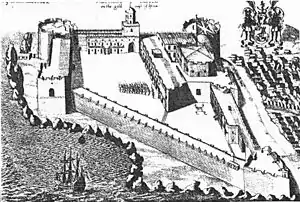Swedish Africa Company
The Swedish Africa Company (Swedish: Svenska Afrikanska Kompaniet) was a Swedish trading company, founded in 1649 on the initiative of the Walloon-Dutch merchant Louis De Geer and his son Laurens, for whom Sweden had become a second home. The primary interest of the company was the trade on the Swedish Gold Coast. The establishment of the pseudo Swedish Africa Company caused much astonishment in the Amsterdam city council.
 Fort Carolusborg | |
| Founded | 1649 |
|---|---|
| Founder | Louis De Geer |
| Defunct | 1663 |
| Headquarters | Hamburg, Stade, Göteborg |
Key people | Laurens De Geer, Hendrik Carloff, |
| Products | tobacco, sugar, gold and African slaves |
History
In 1648 De Geer's charter on exporting Swedish copper ended. Along with his son Laurens, and with a royal charter of Christina I of Sweden he founded the Swedish Africa Company, but moved its base from Gothenburg to Stade. The company was founded after Hendrik Carloff, a former high-ranking administrator of the Dutch West India Company, had offered his help, promoting his good relation with a local chief.
Caerloff was hired for three years as commander and director at a salary of one hundred guilders and an ounce of gold per month to cover the charges. He was embarking on the Elbe and thence sailed to Africa. He arrived at the Gold Coast on April 22, 1650. Carloff signed a contract for the purchase of land with the chief of Efutu. There was a conflict with the Company of Merchants Trading to Guinea negotiating with Henniqua, a cousin of King of the Fetu about an English trading post. On May 28, 1650 both Sweden and the English signed a treaty with the chief. The English obtained the right to trade for only half a year.[1]
Carloff occupied Butre in 1659, Annemabo in 1651 and Orsou in 1652. On his return in September 1652 Carloff and his ship Christina were seized and taken to Plymouth. His ship was transporting about twenty bags of gold and 6,500 elephant teeth.[2] The gold rings, necklaces and bracelets were taken to the Tower of London. Meanwhile, his men started building Fort Carolusborg and conquered Tacorary in 1653. In Sweden Carloff was promoted to general and knighted on May 3, 1654 under the name Carloffer. It seems he occupied Jumore (Fort Apollonia) and Cabo in 1655. In 1656 Fort Batenstein was recaptured by the Dutch. In 1656 Carloff was accused of private trade. Johann Philipp von Krusenstjerna (1626–1659) took over the post of governor. Annoyed, Carloff left the colony and deserted to Denmark on March 27, 1657.
He then founded the Danish Africa Company and recaptured Carolusburg from the Swedes. Because of the Dano-Swedish War he ordered to sell Carolusborg to the Dutch if the garrison entered into trouble.
The establishment of both the Swedish and Danish Africa Company should be seen in the light of the mismanagement of the Dutch West India Company. This company went bankrupt in both 1636 and 1647, and was eventually dissolved in 1674.[3] Both the Swedish and the Danish company were founded by Dutchmen who tried to evade the West India Company's monopoly and used the company's mismanagement to make a private profit.
The Swedish Africa Company was formally abolished in 1663, after the West India Company paid compensatory damages to the Swedes.
References
- R. Porter: The Crispe Family and the African Trade in the seventeenth Century, p. ?. In: Journal of African History. 9, 1, 1968, ISSN 0021-8537
- http://www.british-history.ac.uk/report.aspx?compid=55252&strquery=Caarloff
- A more successful second Dutch West India Company was founded in 1675.
